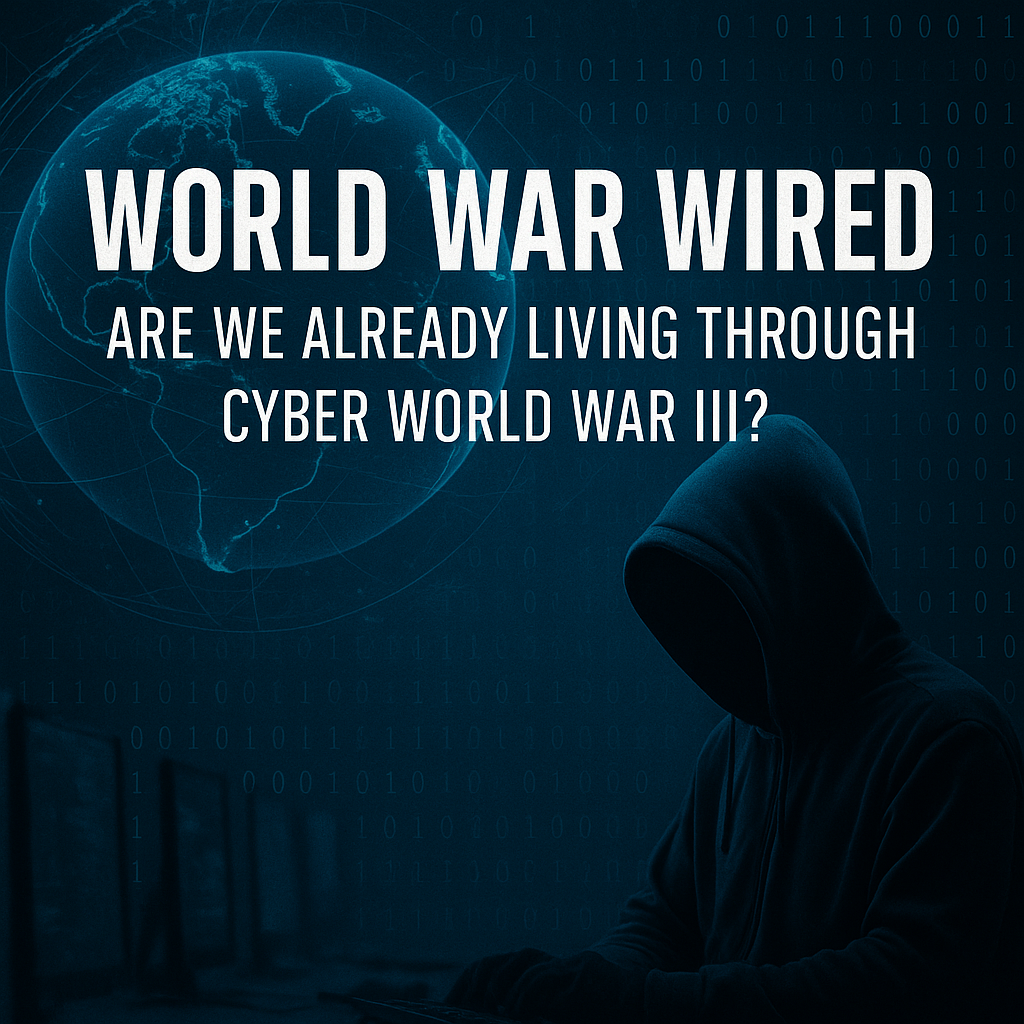World War Wired: Are We Already Living Through Cyber World War III?
Cyber warfare is no longer a future threat it’s a daily reality shaping global power struggles. From Russian sabotage to Chinese espionage, this invisible war targets critical infrastructure and civilian life, raising the question: Are we already in Cyber World War III?

By 2025, "cyber warfare" is no longer in the domain of science fiction or sensational think tank analyses. It is the insidious, omnipresent reality that is remaking the world's great powers. From malware assaults on American infrastructure to Chinese and Russian state-sponsored cyber heists, the virtual battlefield is as significant as any battlefield of traditional conflict.
The question is no longer whether cyber war will spill over into full-scale conflict it's whether we are already experiencing Cyber World War III without acknowledging it.
The Invisible Frontlines of Cyber Conflict
Traditional war doesn't start with tanks or missile barrages. Cyber warfare doesn't start that way either. It begins with strings of code inserted stealthily into key systems, aimed at disrupting, stealing, or destroying.
The past decade has seen billions spent by countries on offensive cyber operations. In 2023, a report by the Council on Foreign Relations estimated that China, Russia, Iran, and the United States have all established highly sophisticated cyber forces responsible for everything from corporate espionage to disruption of national infrastructure.
One of the most distinguishing features of this emerging warfare is plausible deniability. The attackers hide behind proxies and botnets and conceal their identities, making attribution heavy-footed and politically sensitive. This ambiguity makes it possible for state actors to probe red lines without eliciting an instantaneous kinetic response.
But the scope of these operations leaves no room for doubt that cyber war has evolved into a full-spectrum competition. When Russian malware can bring down U.S. pipelines, and Chinese hackers can pilfer whole treasure troves of sensitive defense information, the stakes are no longer theoretical.
Russia's Playbook: Disruption and Destabilization
Russia has been a forceful leader in cyber operations. The 2017 NotPetya attack, originally aimed at Ukraine, rapidly escalated into the most expensive cyberattack to date, causing over $10 billion in damages worldwide.
Recently, in 2022 and 2023, Russian-affiliated actors have been involved in:
- Ransomware attacks targeting American hospitals and city governments
- Phishing campaigns targeting NATO defense contractors
- Disinformation campaigns meant to heighten political polarization
As Google Trends reports, search for "Russian cyber attacks USA" increased by more than 300% in early 2023 as news of these attacks increased.
These campaigns are more than mere criminal activity. They are calculated attempts at destroying Western institutions' trust and imposing economic and psychological burdens all without firing a single shot.
China's Strategy: Silent Extraction
Whereas Russia likes loud, attention-grabbing attacks, China's strategy is quiet and methodical. Its aim: long-term penetration and data exfiltration.
China's military Unit 61398, or APT1, has been attributed to years of relentless attacks on U.S. corporations, universities, and government institutions. A 2021 U.S. Department of Justice indictment accused Chinese hackers of stealing billions in trade secrets in industries from solar energy to aviation.
The 2015 Office of Personnel Management hack by Chinese actors breached sensitive background data on more than 22 million Americans, including security clearance information. Cybersecurity professionals have labeled it the most devastating espionage campaign in American history.
Although Western news sometimes covers high-profile ransomware attacks, most analysts contend that China's stealthier intrusions represent the greater existential threat because they chip away at technological superiority and national security over decades.
Iran's Growing Cyber Presence
Less well-endowed than Russia or China, Iran has become an increasingly formidable cyber presence. Sanctions and local rivalries have underpinned Iranian investment in asymmetric capabilities to counterbalance.
Since the Stuxnet assault, which destroyed Iranian nuclear centrifuges in 2010, Tehran has invested substantially in cyber capacity to deter and retaliate against potential aggression. Prominent operations include:
- Shamoon virus attacks erasing data from Saudi Aramco in 2012
- Distributed denial-of-service (DDoS) assaults on big U.S. banks
- Spear-phishing attacks against American policymakers and think tanks
In the spring of 2024, Iranian actors were involved in a wave of ransomware assaults on multiple U.S. port commissions, temporarily disrupting supply chains in a show of economic pressure.
America's Cyber Arsenal
America is far from a passive victim. Indeed, it has the most sophisticated offensive cyber powers on the planet.
By way of U.S. Cyber Command and the National Security Agency (NSA), the United States has created capabilities to:
- Disrupt the critical infrastructure of adversaries
- Hack into weapons systems
- Carry out counter-propaganda efforts
One of the few publicly acknowledged examples is Operation Olympic Games, the Stuxnet worm's code name. But most American cyber operations are classified, happening in the dark where deniability is maintained.
In 2023, reputable outlets broke stories of the U.S. installing "persistent engagement" malware within Russian power networks and Chinese telecoms systems waiting to be turned on in case of provocation.
Why "Cyber World War III" Is Not Hyperbole
Though critics may sneer at the term "Cyber World War III," the word describes the magnitude and duration of conflict:
- Over 90 countries have offensive cyber operations
- Corporate losses due to cybercrime are estimated to hit $10.5 trillion a year by 2025
- Hospitals, power grids, and food supply chains the civilian infrastructure have emerged as a top target
As opposed to previous world wars, this one is:
- Ongoing, not episodic
- Worldwide, not regional
- Intransparent, not transparent
Cyber weapons are used every day, causing economic damage and pushing the limits of international law. And since these attacks don't result in instantaneous casualties, they frequently don't provoke proportionate reactions, setting up a scary precedent of escalation by rote.
How Escalation Can Go Kinetic
There are many analysts who worry about a tipping point: a cyber attack that reaches an unacceptable level, prompting a military response.
Consider the scenario: a nation cripples the power grid of a major city, leading to loss of life in hospitals and transportation accidents. Under international law, such an attack could be treated as an act of war.
A 2024 Rand Corporation simulation summed up that the likelihood of a cyber attack igniting kinetic conflict will increase dramatically within the next five years, particularly as cyber weapons are commoditized and transferred to proxy forces.
The Role of Private Actors
Perhaps the most disquieting part of cyber conflict is the role played by private criminal actors as proxies for states.
Ransomware groups such as REvil and DarkSide have become de facto mercenaries, giving governments plausible deniability while conducting attacks in support of state goals.
This fusion of criminal activity and statecraft is a feature of 21st-century warfare. As cybersecurity journalist Nicole Perlroth noted, "It's no longer possible to separate organized crime from geopolitical maneuvering."
Why Deterrence Is Failing
When the Cold War era arrived, mutual assured destruction detoured nuclear escalation. However, in cyberspace, deterrence is not working because:
- Attribution is hard and slow
- Responses tend to be disjoined across jurisdictions
- Consequences are hardly timely or proportionate
When attackers can avoid meaningful retaliation, the desire to keep going increases. That is why attacks against critical infrastructure have proliferated, encouraging adversaries to push further.
Building Resilience Before It's Too Late
If Cyber World War III is already in progress, the emphasis has to change from denial to resilience and accountability.
Priorities include:
- Upgrading cybersecurity for key infrastructure
The Colonial Pipeline attack showed how legacy systems can become points of catastrophic failure.
- Enhancing public-private partnerships
Private hands hold many targets. Information-sharing and cooperation are not options.
- Creating unambiguous doctrines for proportional response
If enemies recognize the price of escalation, they are likely to act with restraint.
- Global norms and agreements
Even flawed structures such as the Geneva Conventions have served to contain war. A virtual equivalent is overdue.
Conclusion: The War We Don't Want to Name
It's uncomfortable to frame ourselves as belligerents in an international cyber war, but denial only encourages those who take advantage of our reluctance.
Cyber World War III isn't arriving. It's arrived.
We simply haven't acknowledged it.
And until we acquire the will of the collective to protect our institutions and punish aggressors, the war beneath the surface will persist line by line of bad code, breach by breach, blackout by blackout.
Sources
- CourtListener – Case filings on cybercrime prosecutions
- Justia – United States v. APT1 and other indictments
- Archive.org – Archived reports and threat assessments
- Google Trends – Search interest: “Russian cyber attacks USA,” “Chinese cyber espionage,” “Iran ransomware attacks”
- Reputable news outlets: The New York Times, The Washington Post, Reuters, BBC, Wired
- Official press releases: U.S. Department of Justice, Cybersecurity & Infrastructure Security Agency (CISA)
For more legal exposes and truth-behind-glamour stories, subscribe to AllegedlyNewsNetwork.com




